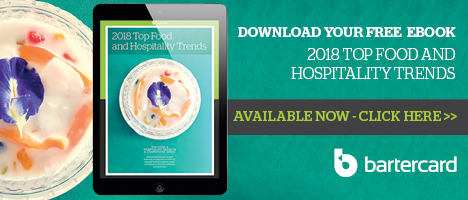2018 Top Food and Hospitality Trends

The food and hospitality scene is a competitive space. From concept dining to the latest technology shaping menus and fitouts, these top food and dining trends will keep you in the loop and dining outside the box.
Food
Table Tech
Being too tired to cook or pick up dinner is creating a multibillion dollar industry - apps like UberEats and Deliveroo are bringing food straight to customers’ doorsteps from a curated list of local restaurants. It’s a crowded market where a spate of new apps are on the rise, and whilst not all venues are on board, restaurateurs should consider the space and requirements to manage pickups. Tech’s also found on more tables where customers are ordering food and drinks off apps at their convenience. Meanwhile UK outfit DelivAir is using drones, GPS and smartphone signals to bring food straight to customers.
Reservations are back
Table for two? Get in the queue – is the route many restaurateurs have taken in a no reservations, walk-in approach, seating customers on a first come basis. Alternatively restaurants like Momofuku do small-scale seating without waiting lists which, when five star reviews are added, skyrockets demand. But in 2018 reservations are coming back to make restaurants more accessible. This is thanks in part to Google who’ve just launched insights into wait times and peak visiting periods, giving customers more control of bookings and how long they wait.
Cashless Dining
More eateries and bars are integrating technology that lets customers transact without cash or cards. Alipay has a 520 million user base and lets 1.4 million Chinese visitors in Australia pay the way they like most – on their smartphones and in their own currency. Alipay arrived on the Gold Coast at the end of 2017 and launches in other parts of Australia shortly to shape the visitor experience and boost spending. Find out more about Alipay here.
Watch out for these additional food trends taking off in 2018: creative use of upcycled surrounds, high-end, no-alcoholic drinks and farm-to-shaker cocktails.
Hotels
Co-living spaces
While Airbnb is the alternative to hotels, hotel brands are starting a new version of accommodation through co-living spaces. Visitors can choose the level of privacy or community they want to experience like at AccorHotels’ brand Jo&Joe where a new ‘open house’ category includes open-plan, collaborative kitchens, a bar for locals and guests, a ‘happy house’ creating a ‘home-like’ experience and dormitory-style bedrooms. The brand is also doing out-of-the-ordinary (OOO!) accommodation like mud huts and beach shacks. Time will tell whether this approach takes off, but it does cater to a market of travellers who want a radically different experience to the everyday hotel stay.
Pop-up vacations
Individually designed rooms are already in place and pop-up restaurants are a thing, but the next step is pop-up hotels in a variety of places. 700,000 Heures, a newly launched hotel group, is calling itself the first wandering hotel in the world where locations at private residences change every six months. The average life expectancy of a person is 700,000 hours and the world is too rich to take trips which look alike – is the concept underpinning a new iteration of accommodation letting guests enjoy tailored experiences and explore places like a local.
Bartercard – helping restaurants and hotels succeed for 27 years
Bartercard is a business marketplace where members exchange products and services without the use of cash – boosting cash flow to fund business expansion, attracting new customers and increasing profits along the way. We know small business inside out and can put your restaurant or hotel brand ahead of the curve.
FREE ebook
Download Bartercard’s FREE e-book, 2018 Top Food and Hospitality Trends to stay ahead of the curve.
February 20th 2018.
















